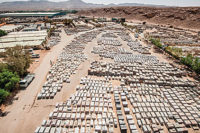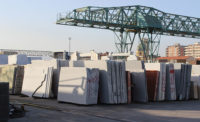The stone quarrying region of Trapani is considered Italy’s third most important quarrying basin after Massa Carrara and Verona. It produces 15% of Italy’s marble — and 85% of that of Sicily.
For the past 1,500 years, stone from Sicily has been shipped to mainland Italy and Europe to be used for churches and basilicas. One of the region’s most prized stones is Perlato di Sicilia, a light ivory-colored marble. Additionally, Sicily produces a broad range of colored stone, with tones ranging from ivory to lava black, and including apricot, rose, red, and gray to breccias and jaspers.
The consortium includes 260 employees from the 25 member companies, and it produces a yearly output of stone products totalling $35 million (28 million euros). These companies quarry, fabricate or restore the stones. They employ all of the most modern manufacturing processes to insure that the stones can be used for interior, exterior and decorative use.
One of the main priorities of Consortium Lapis is to promote the consistency of color found in Sicilian stones as well as the technical qualities of the material. Working as a consortium allows stone producers to control the quality of products that are exported.
Earlier this year, the Italian-American Chamber of Commerce of Chicago organized a trip for fabricators, architects and designers, as well as Stone World, to visit local quarries of Perlato, Perlatino, Ivory Venato and Grigio Billiemi. Upon arrival, the U.S. group received generous hospitality from many members of Consortium Lapis. The following pages will illustrate the various companies that were visited — from quarries to slab production facilities to cut-to-size shops.






